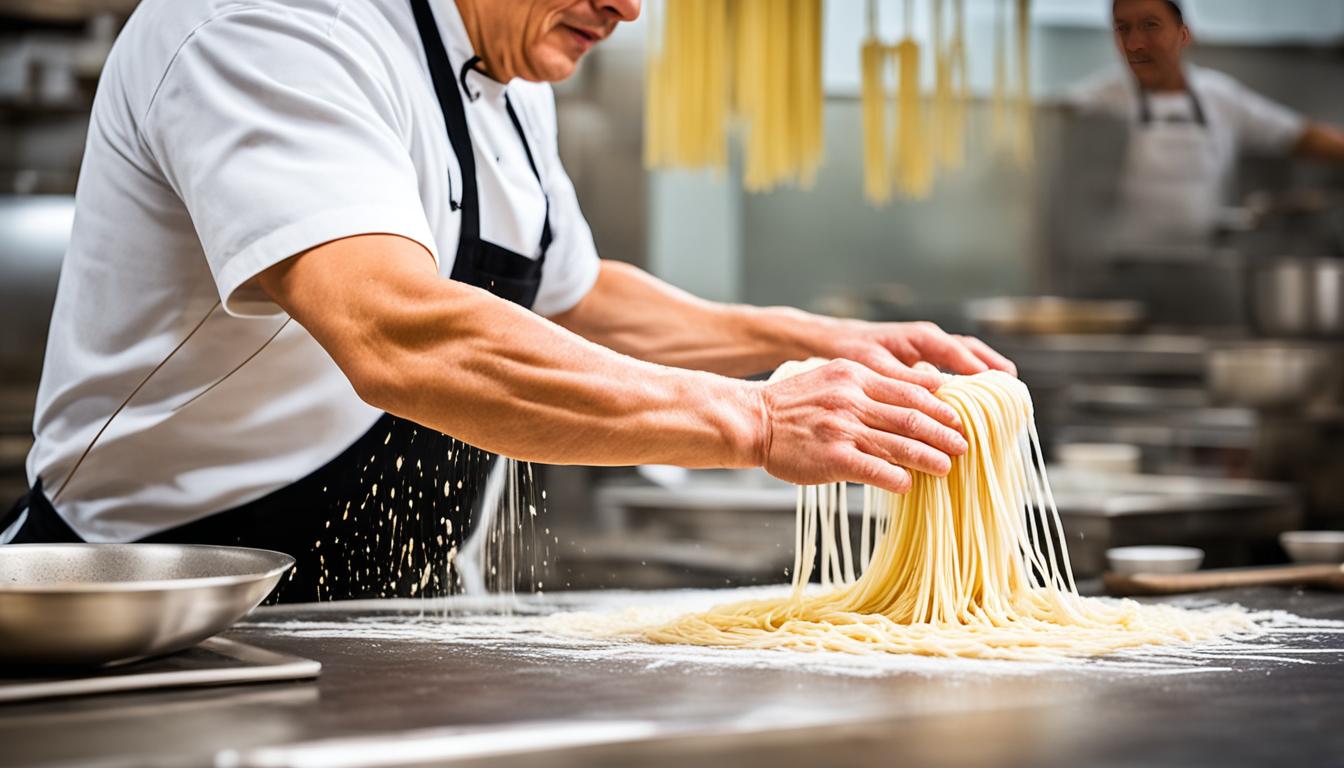Have you ever wondered how to create authentic Chinese noodles that rival the quality of a professional noodle shop? The secret lies in mastering the traditional hand-pulling technique of making fresh lamian noodles. But where do you begin? How can you ensure the noodles have the perfect texture and taste?
In this article, we will guide you through the noodle making process, from mixing the dough to stretching and shaping the noodles. Together, we will explore the intricacies of handmade lamian and unlock the secrets of premium quality noodles. Are you ready to embark on a journey of artisanal noodle craftsmanship? Let’s dive in!
Throughout this guide, we will share expert tips, trusted recipes, and important techniques that will help you create your own homemade lamian with confidence and finesse. We believe that with practice and dedication, you can become a master of the art of hand pulled lamian noodles, right in the comfort of your own kitchen. So, are you ready to take the challenge and elevate your noodle game to new heights?
Mixing the Dough and Working with Sticky Noodles
When it comes to making hand pulled lamian noodles, one of the challenges we often encounter is dealing with sticky dough. The dough is typically made by mixing flour, water, and salt together. Some recipes may call for additional ingredients like nutritional yeast.
Mixing the dough can be done using a food processor or a stand mixer if a food processor is not available. Once the ingredients are mixed, the dough is usually sticky, which can make it difficult to work with. To overcome this challenge, it’s important to keep the dough moving and avoid letting it stick to the work surface.
Some suggest using a glass work surface for dealing with sticky dough, but it’s not clear if it affects the stickiness of the dough. However, using a glass work surface can provide a smooth and non-stick surface, which may be beneficial.
If the dough is still too sticky, adding flour can help reduce its stickiness. However, it’s crucial to add flour carefully to avoid altering the texture and taste of the noodles. It’s recommended to add small amounts of flour gradually and knead it into the dough until the desired consistency is achieved.
Once the dough is properly mixed and less sticky, it’s essential to let it rest for a certain period of time. Resting allows the gluten in the dough to relax, making it easier to handle and stretch. Additionally, oiling the dough before twisting and pulling can contribute to the desired texture and smooth handling.
Key Takeaways:
- Mixing the dough for hand pulled lamian noodles can result in a sticky texture.
- Using a glass work surface may help with stickiness, but it’s not proven.
- Adding flour gradually can reduce stickiness without compromising texture and taste.
- Resting the dough allows the gluten to relax and makes it easier to handle.
- Oiling the dough provides a smoother texture for twisting and pulling.
Achieving Uniformity and Avoiding Tearing
When it comes to making hand-pulled lamian noodles, achieving uniformity in the diameter can be quite challenging, especially for beginners like us. The key is to handle the dough with care, ensuring that we stretch and shape it evenly to avoid creating extremely thick or thin parts. Unevenness in the dough can easily lead to tearing while pulling the noodles, which is something we want to avoid.
It’s not uncommon for tearing to occur after a few pulls, and this can often be attributed to the unevenness in the dough. To overcome this challenge and improve the consistency of our noodles, we need to practice the twisting and pulling techniques diligently. By doing so, we can create noodles with an even diameter throughout the strands, resulting in a more pleasing texture and appearance.
Mastering these techniques requires patience and practice. We need to pay careful attention to the stretching and shaping process, ensuring that the dough is properly elongated and shaped before pulling. This will help us achieve noodles with a uniform thickness and minimize the risk of tearing, giving our homemade hand-pulled lamian noodles that desired noodle consistency we all love.
